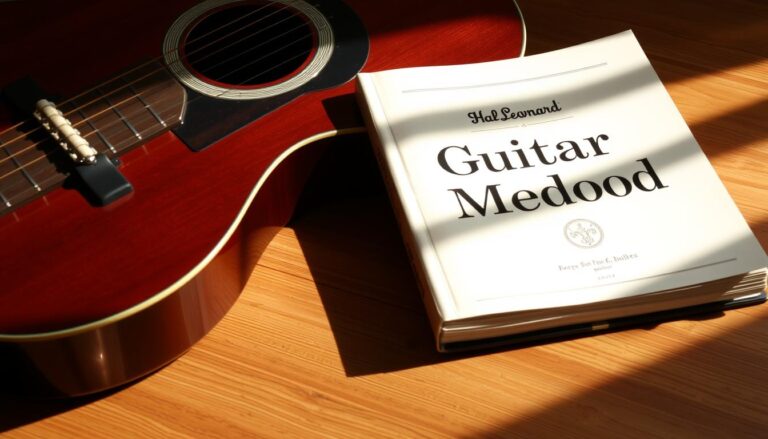The Best Book to Learn Guitar: A Comprehensive Guide
This introduction frames a product roundup of market-leading instructional titles and companion texts. It outlines decision criteria such as curriculum breadth, included audio and video, progression design, editorial quality, and verified customer ratings. The goal is to help U.S. buyers identify one definitive choice and supporting titles that accelerate proficiency for different players and outcomes.
Context matters: thousands of instructional books still sell despite online lessons. Buyers should expect paperback, series sets, and integrated online media. Time invested in a structured method often yields measurable skill gains faster than ad hoc practice.
Evaluation focus: this guide weighs progression design, multimedia assets, and long-term ratings. It explains when a focused companion title—exercises, theory, or method—adds clear value rather than redundancy. Readers will get a preview of all-in-one methods, fast-start primers, exercise systems, and theory texts mapped to common goals.
Key Takeaways
- Scope: a curated list of market-leading instructional options for U.S. buyers.
- Criteria: curriculum, audio/video, progression, editorial quality, verified ratings.
- Formats: expect paperback, multi-volume series, and online media access.
- Companions: targeted exercise or theory titles can speed progress for specific players.
- Outcome: the right resource structures daily work and compounds practice into skill.
How we chose the best guitar books for 2025
Selection prioritized titles with clear curricula, documented adoption, and modern media access.
The evaluation used defined pillars: curriculum scope by type (method, primer, exercise, theory), audio/video inclusion, and clarity of the learning path for different players.
Evidence-based scoring weighted review volume and averages. For example, titles with 4.5-star averages and thousands of ratings scored higher for reliability and user satisfaction. Cost-to-value analysis favored multi-volume methods with online audio over single, text-only editions when they reduced friction and shortened time-to-skill.
Author credibility and publisher stability were decisive factors. Established educators and Hal Leonard-style editorial oversight indicate sustained updates over years and higher long-term value.
Materials were ranked by learning efficiency and age/level fit. Fast-start primers and exercise systems that convert reading into playing quickly ranked higher for busy readers and beginners. Theory texts were allocated by stage to prevent overload and provide a clear advance path for serious study.
Our top picks by player goal and level
This list matches titles with specific objectives and practical limits on time and scope. Each entry notes core features, media included, and an explicit use-case boundary so readers allocate value correctly.
Guitar for Dummies (Phillips & Chappell)
Scope & media: Nearly 400 pages with 85 videos and 95 audio tracks online; 4.3-star average. Ideal where broad coverage and immediate audio/visual feedback speed progress.
Teach Yourself to Play Guitar
Quick-start primer: 47 pages, diagram-heavy, 86% 4–5-star reviews and 15,000+ ratings. Use when the priority is fretting chords and getting into songs fast.
Hal Leonard Guitar Method (Schmid & Koch)
Young learners: Three sequential volumes (~50 pages each) with online audio. Best for classroom pacing or instructor-guided progression.
Guitar Aerobics & practice boosters
Daily routines: Guitar Aerobics supplies 365 focused drills with backing tracks and a 4.5-star average. Guitar Head’s 100 drills add structured short sessions and audio reference for consistent execution.
Theory and advanced reference
Applied theory: Tom Kolb’s volume links quizzes and ~100 audio examples to instrument-specific topics. For comprehensive academic depth, Clendinning & Marvin’s 800-page text serves as a long-term reference.
“Match the title to the objective and avoid overlap; one clear method and one theory companion usually deliver the best value.”
best book to learn guitar for beginners
Beginners progress quickest when instruction centers on playable chords, steady rhythm, and immediate song practice. A compact primer that stresses songs and diagrams offers rapid payoffs for limited practice time. Teach Yourself to Play Guitar exemplifies this approach: 47 pages, diagram-heavy, and 86% 4–5-star reviewer satisfaction.
Quick-start learning: chords, simple songs, and strumming patterns
Prioritize fast wins: introduce open-position chords, basic strumming, and short two-string melodies to build confidence. Set micro-goals such as three usable chord shapes per week and one simple song.
Practice template: 30–45 minute session: 5 minutes tuning and set-up; 10 minutes chord changes; 10 minutes strumming with metronome; 10 minutes song application; optional 5 minutes review. Emphasize rhythm first to avoid unstable timing.
Tab vs. standard notation: what helps beginners progress faster
Tabs accelerate early playability, while standard notation builds long-term literacy. Hal Leonard Method favors notation and offers online audio, which aids timing and tone but may omit deeper theory for adult learners. Start with tabs for quick songs, then integrate notation through a method series as proficiency grows.
- When to add multimedia: add audio/video if strumming or feel stalls.
- Retention tip: revisit the same song across multiple days to solidify motor memory.
Technique, exercises, and practice plans that actually stick
Structured daily drills create measurable gains when paired with clear tempo targets. This section presents a compact, evidence-based routine that fits limited time and yields transfer to real music.
Build daily momentum with Guitar Aerobics and metronome targets
Guitar Aerobics prescribes one focused drill per day. The weekly rotation targets alternate picking, string skipping, bending, arpeggios, sweep picking, legato, and rhythm.
Implementation: start 10–20 BPM below comfort, then add 2–4 BPM per session when accuracy and tone meet the threshold.
Ten-minute routines from Guitar Head’s 100 exercises
Use three micro-drills from the 100-exercise catalog for ten-minute bursts. Select items that address weakness, use online audio, and apply backing tracks for feel calibration.
- Daily plan: one drill per day with explicit BPM targets and weekly review.
- Rotate focus: alternate picking, synchronization, legato, and rhythm to avoid plateaus.
- Track outcomes: log BPM, errors, and remediation notes; reassess every 12 weeks.
- Translate: end each session by applying the drill to a riff or song excerpt for playing guitar fluency.
| Program | Format | Daily Focus | Avg. Rating |
|---|---|---|---|
| Guitar Aerobics | Drills + backing tracks | Weekly rotation (7 areas) | 4.5 (3,000+) |
| Guitar Head: 100 Exercises | 100 drills + audio | Short progressive drills | 4.5 (3,400+) |
| Micro-session plan | 10-minute modules | 2–3 drills per session | Operational |
“One focused drill per day, measured and incremented, converts repetition into real technique.”
Music theory books that make you a better guitarist
A clear sequence of theory texts converts abstract concepts into practical fretboard skills. Start with accessible overviews, move to instrument-focused manuals, and reserve academic references for advanced study.
From fretboard logic to modes: Tom Kolb’s roadmap for guitarists
Music Theory for Guitarists maps key signatures, intervals, scales, and chord construction to positions on the neck. It includes ~100 audio tracks and quizzes that validate progress.
Beginner-friendly fundamentals: Michael Miller’s Idiot’s Guides
Idiot’s Guides: Music Theory is a 300-page primer covering rhythm, melody, harmony, and arranging. Use it as the foundational text for structured study and ear-training exercises.
Guitar-centric diagrams and charts: Idiot’s Guides: Guitar Theory
David Hodge’s guide emphasizes tabs, notation, and chord/scale appendices. It accelerates lookup and application during practice sessions focused on technique and repertoire.
When to step up to a full textbook: The Musician’s Guide to Theory and Analysis
Clendinning & Marvin’s volume serves professional study: part-writing, large-form analysis, and formal exercises best suited for advanced students and educators.
“Sequence materials: primer → instrument-specific → academic. Pair chapters with short exercises and ear tasks so theory translates into technique.”
- Practical sequence: start broad, add guitar-specific texts, then graduate to academic analysis.
- Study method: couple each chapter with short exercises and focused ear training.
- Targeted reading: consult scales, chord function, and modal harmony when repertoire demands those concepts.
Books vs. online lessons: what delivers faster results today
Deciding between printed materials and interactive lessons is primarily a question of feedback and accountability.
Structured pathways and feedback close the loop that static text cannot. Books provide depth and durable reference, but platforms add real-time demos, progress tracking, and correction.
Structured pathways and feedback vs. static reading
Engagement metrics show platforms with reminders and checkpoints reduce abandonment. Progress tracking converts idle minutes in a day into measured practice and raises retention over years.
Hybrid approach: pair a method book with video demos and audio tracks
One effective way is an all-in-one book with companion media plus a subscription pathway for weekly checkpoints. This stack lowers cost-per-session versus recurring lessons and preserves instructor access via asynchronous reviews.
- Role of the guitar teacher: targeted feedback via video submissions eliminates performance pressure and improves correction timing.
- Implementation: schedule two online touchpoints per week and anchor daily drills to the matching book chapter for compounding value.
“Hybrid study merges permanence and interactivity, producing faster, more durable progress.”
How to choose the right guitar book for your learning style and goals
Match the format of the resource to a learner’s cognitive style and weekly availability for effective progress. A clear diagnostic saves time and prevents wasted purchases.
Visual, text-based, or hands-on: match format to how you learn best
Visual learners need video demonstrations and slow-motion breakdowns. Choose titles with strong companion media.
Text-based learners prefer detailed explanations, charts, and structured chapters. A well-edited title from a reputable author and publisher reduces ambiguity.
Hands-on players require drill-heavy formats with short modules and backing tracks so practice converts to skill.
Set specific outcomes: songs, chords, technique, or theory
Define one measurable goal per month: three chords, one song, a technique milestone, or a theory concept. Select a resource that maps chapters to that outcome and assigns practice tasks.
Budget, time, and value: balancing cost, author expertise, and included audio/video
Prioritize integrated media when practice time is limited. A modest increase in cost often yields higher value through guided sessions and files that speed progress.
| Format | Media | Best fit for | Typical cost |
|---|---|---|---|
| Visual-first title | Video + audio | Demonstration-led learners | $20–$35 |
| Text-centric manual | Charts + notation | Analytic readers | $15–$30 |
| Practice-driven drills | Backing tracks | Hands-on players | $12–$28 |
“Choose a single structured method, add one exercise volume, and include a theory reference only when needed.”
Conclusion
For measurable progress, combine a single structured method with short, daily practice and targeted media. Match a primary method book to defined goals, then add an exercise volume and a focused theory reference to close gaps efficiently.
Execution matters: consistent short drills and song-based sessions outperform sporadic long practice. Use Guitar Aerobics-style routines, tempo targets, and backing tracks for steady gains.
Adopt a hybrid path: pair your selected book with demonstration videos and periodic instructor feedback. Reassess materials every 8–12 weeks and add fretboard, chord function, and scales when repertoire requires them.
Pragmatic final step: pick one method today, schedule brief daily practice, and use media support and a teacher check-in to reduce errors and accelerate learning music.
FAQ
Which single title provides the most complete curriculum for a beginner aiming for steady progress?
The combination of a method book with integrated audio/video and a daily exercise routine produces the most consistent results. For a structured curriculum, a comprehensive method that includes clear chord progressions, reading primers, and multimedia support offers broad coverage and practical drills. Pair that with a 10–15 minute daily exercise plan focused on timing and fretboard mapping for measurable improvement.
How were the recommended titles selected for 2025?
Selection criteria prioritized pedagogical clarity, author credentials, included multimedia, progression logic, and peer-reviewed adoption in instruction. Titles were evaluated for pacing, notation coverage (tab and standard), repertoire diversity, and the presence of measurable practice plans. Market adoption and instructor recommendations informed final choices.
What is the most efficient practice routine for steady technical gains?
A balanced routine allocates time to warm-up (5 minutes), targeted technical work (10–15 minutes with progressive exercises), repertoire or song practice (10–20 minutes), and theory/ear training (5–10 minutes). Using metronome-based increments and rotating focus areas across the week maintains momentum and prevents plateauing.
Should beginners use tablature or standard notation first?
Tablature accelerates early song acquisition and fretboard orientation; standard notation develops long-term reading, rhythmic accuracy, and broader musical literacy. Effective paths combine both: start with tab for rapid playable results, then introduce standard notation and rhythm reading within the same curriculum.
Which resources best teach music theory directly applicable to the fretboard?
Guitar-focused theory guides that map intervals, scale shapes, and chord construction onto the fretboard are most practical. Resources that include fretboard diagrams, applied examples, and exercises for transposition and chord-scale relationships provide the fastest transfer from concept to playing.
Can a single method replace weekly lessons with a teacher?
A high-quality method plus multimedia can substitute for some teacher functions, such as structured progression and demonstrations. However, instructors deliver personalized feedback, error correction, and tailored pacing. For accelerated skill development, combine a method book with periodic lessons or online coaching.
How should a working professional choose material given limited practice time?
Prioritize resources that offer short, high-impact exercises, defined learning outcomes, and integrated audio. Set weekly targets (e.g., learn two chords, master one song section, increase metronome speed by 5–10%) and track progress. Budget for one reliable method and one exercise resource that fits 10–20 minute daily windows.
When is it appropriate to transition from beginner materials to a music theory textbook?
Transition when the player consistently navigates basic chords, reads simple notation, and seeks deeper harmonic and formal analysis. At that point, a comprehensive textbook that covers harmony, voice-leading, and analysis provides the academic framework useful for composition, arranging, and advanced improvisation.
Are daily one-exercise programs like Guitar Aerobics effective for long-term improvement?
Yes — concise, progressive daily exercises build technical consistency and timing when combined with varied repertoire work. The key is progression, metronome use, and incremental difficulty increases. Complement daily drills with contextual practice to ensure musical application.
How should one evaluate the value of a title relative to cost?
Assess value by author expertise, included multimedia, progression structure, and whether the material aligns with defined goals (songs, technique, theory). Calculate time-to-outcome: a slightly higher-priced resource that reduces learning time or provides ongoing reference often represents better long-term value.






